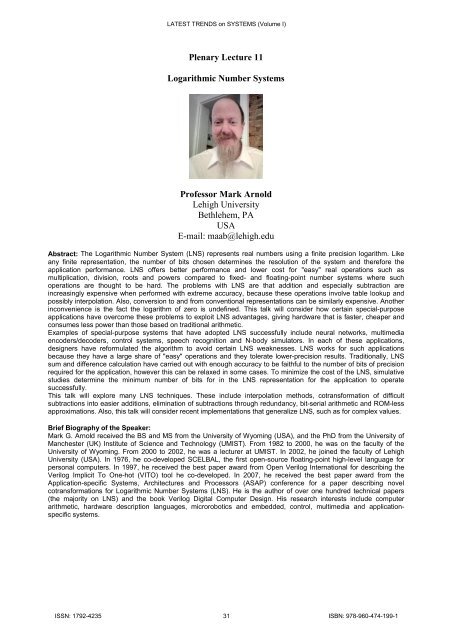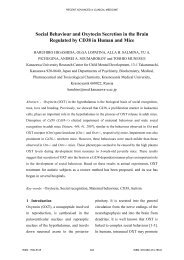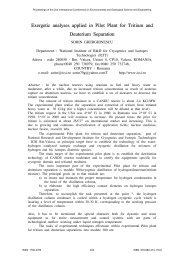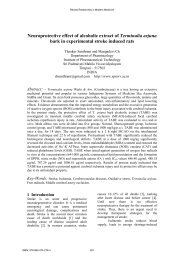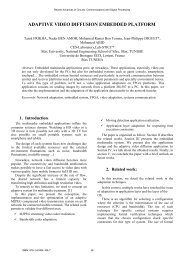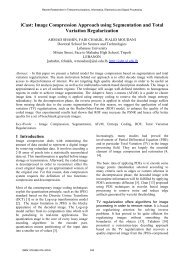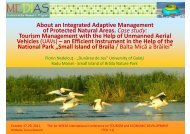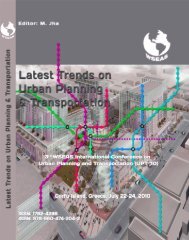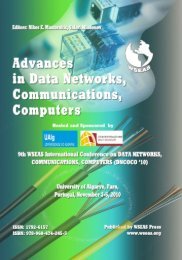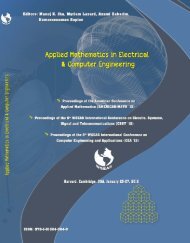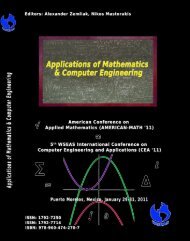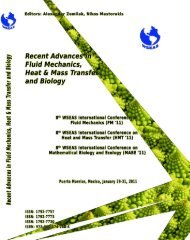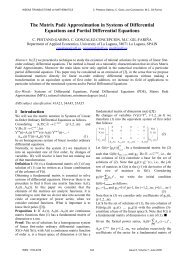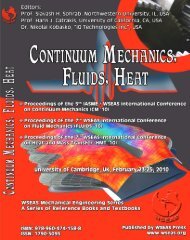Latest trends on systems - Wseas.us
Latest trends on systems - Wseas.us
Latest trends on systems - Wseas.us
- No tags were found...
Create successful ePaper yourself
Turn your PDF publications into a flip-book with our unique Google optimized e-Paper software.
LATEST TRENDS <strong>on</strong> SYSTEMS (Volume I)Plenary Lecture 11Logarithmic Number SystemsProfessor Mark ArnoldLehigh UniversityBethlehem, PAUSAE-mail: maab@lehigh.eduAbstract: The Logarithmic Number System (LNS) represents real numbers <strong>us</strong>ing a finite precisi<strong>on</strong> logarithm. Likeany finite representati<strong>on</strong>, the number of bits chosen determines the resoluti<strong>on</strong> of the system and therefore theapplicati<strong>on</strong> performance. LNS offers better performance and lower cost for "easy" real operati<strong>on</strong>s such asmultiplicati<strong>on</strong>, divisi<strong>on</strong>, roots and powers compared to fixed- and floating-point number <strong>systems</strong> where suchoperati<strong>on</strong>s are thought to be hard. The problems with LNS are that additi<strong>on</strong> and especially subtracti<strong>on</strong> areincreasingly expensive when performed with extreme accuracy, beca<strong>us</strong>e these operati<strong>on</strong>s involve table lookup andpossibly interpolati<strong>on</strong>. Also, c<strong>on</strong>versi<strong>on</strong> to and from c<strong>on</strong>venti<strong>on</strong>al representati<strong>on</strong>s can be similarly expensive. Anotherinc<strong>on</strong>venience is the fact the logarithm of zero is undefined. This talk will c<strong>on</strong>sider how certain special-purposeapplicati<strong>on</strong>s have overcome these problems to exploit LNS advantages, giving hardware that is faster, cheaper andc<strong>on</strong>sumes less power than those based <strong>on</strong> traditi<strong>on</strong>al arithmetic.Examples of special-purpose <strong>systems</strong> that have adopted LNS successfully include neural networks, multimediaencoders/decoders, c<strong>on</strong>trol <strong>systems</strong>, speech recogniti<strong>on</strong> and N-body simulators. In each of these applicati<strong>on</strong>s,designers have reformulated the algorithm to avoid certain LNS weaknesses. LNS works for such applicati<strong>on</strong>sbeca<strong>us</strong>e they have a large share of "easy" operati<strong>on</strong>s and they tolerate lower-precisi<strong>on</strong> results. Traditi<strong>on</strong>ally, LNSsum and difference calculati<strong>on</strong> have carried out with enough accuracy to be faithful to the number of bits of precisi<strong>on</strong>required for the applicati<strong>on</strong>, however this can be relaxed in some cases. To minimize the cost of the LNS, simulativestudies determine the minimum number of bits for in the LNS representati<strong>on</strong> for the applicati<strong>on</strong> to operatesuccessfully.This talk will explore many LNS techniques. These include interpolati<strong>on</strong> methods, cotransformati<strong>on</strong> of difficultsubtracti<strong>on</strong>s into easier additi<strong>on</strong>s, eliminati<strong>on</strong> of subtracti<strong>on</strong>s through redundancy, bit-serial arithmetic and ROM-lessapproximati<strong>on</strong>s. Also, this talk will c<strong>on</strong>sider recent implementati<strong>on</strong>s that generalize LNS, such as for complex values.Brief Biography of the Speaker:Mark G. Arnold received the BS and MS from the University of Wyoming (USA), and the PhD from the University ofManchester (UK) Institute of Science and Technology (UMIST). From 1982 to 2000, he was <strong>on</strong> the faculty of theUniversity of Wyoming. From 2000 to 2002, he was a lecturer at UMIST. In 2002, he joined the faculty of LehighUniversity (USA). In 1976, he co-developed SCELBAL, the first open-source floating-point high-level language forpers<strong>on</strong>al computers. In 1997, he received the best paper award from Open Verilog Internati<strong>on</strong>al for describing theVerilog Implicit To One-hot (VITO) tool he co-developed. In 2007, he received the best paper award from theApplicati<strong>on</strong>-specific Systems, Architectures and Processors (ASAP) c<strong>on</strong>ference for a paper describing novelcotransformati<strong>on</strong>s for Logarithmic Number Systems (LNS). He is the author of over <strong>on</strong>e hundred technical papers(the majority <strong>on</strong> LNS) and the book Verilog Digital Computer Design. His research interests include computerarithmetic, hardware descripti<strong>on</strong> languages, microrobotics and embedded, c<strong>on</strong>trol, multimedia and applicati<strong>on</strong>specific<strong>systems</strong>.ISSN: 1792-4235 31 ISBN: 978-960-474-199-1


